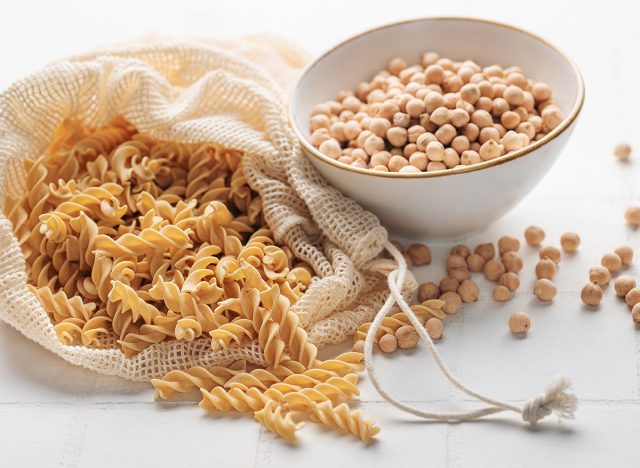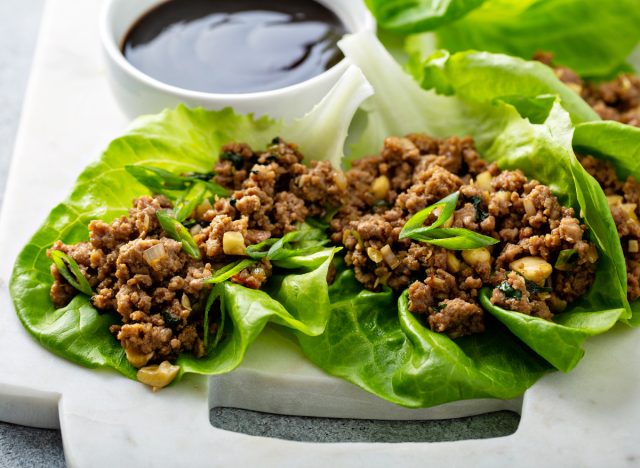We have some great news: you don’t have to completely overhaul your diet to eat healthier. By making a few simple swaps, you can enjoy your favorite foods while boosting nutrients and cutting empty calories. We’ve rounded up food swaps that help you reach your health goals without sacrificing flavor.
From tips to boost protein to swaps that reduce less-healthy ingredients, these changes fit easily into any meal. Whether you’re looking to get more nutrients or feel fuller longer, these swaps can make a positive difference in your overall health and well-being. Read on for some ideas, and for more ways to eat better, check out these 15 High-Fiber Swaps for Faster Weight Loss.
How Smart Swaps Can Improve Diet Quality
- Increase Protein: Protein-rich foods promote satiety, help increase muscle mass, and support weight management. Swapping in higher-protein alternatives can help keep you fuller and provide long-lasting energy.
- Increase Fiber: Fiber is a satiating nutrient that supports a healthy digestive system and gut microbiome. High-fiber swaps are a great way to keep meals filling while promoting gut health.
- Lower Calories: Reducing calories is essential for healthy weight management, which can help prevent and control various health conditions while improving overall well-being.
- Add Nutrients: Swapping in antioxidant-rich vegetables, fruits, or probiotic foods adds vital nutrients to your diet, supporting immune health and protecting against free radical damage linked to chronic disease.
Replace Sweetened Yogurt with Plain Greek Yogurt & Fresh Fruit

Sweetened yogurts are often packed with hidden sugars and can be lacking in protein. To instantly improve your diet, opt for plain Greek yogurt and add fresh fruit for natural sweetness. This swap offers more protein and fewer calories, keeping your breakfast nutritious and satisfying.
Replace Sugary Cereal with Oatmeal

Many cereals are high in sugar and lack filling nutrients like protein or fiber, often causing blood sugar spikes and leaving you hungry soon after. Oatmeal, on the other hand, is an excellent source of fiber, particularly beta-glucan, which studies show can improve feelings of fullness. Top it with fresh fruit or nuts to boost nutrient quality even more.
Replace White Bread with Whole Grain or Sprouted Bread

White bread is a classic source of empty calories, but whole grain bread is rich in fiber, B vitamins, and protein. These nutrients can help keep you fuller longer and add essential nutrients to your diet with a simple swap.
Swap Sugary Drinks for Sparkling Water with Fruit

Sugary sodas and juices can add up quickly in calories and sugar, which can increase the risk of weight gain, diabetes, and heart disease, according to the CDC. Swapping soda for sparkling water with fresh fruit is a refreshing, lower-calorie alternative that helps reduce added sugar while providing you with that bubbly beverage you love. This simple swap can support healthier blood sugar levels and weight management goals.
Swap Mayo with Avocado

Mayo is calorie-dense, with over 180 calories per 2-tablespoon serving. Swap this classic sandwich spread for hummus or avocado to reduce your calories while increasing fiber and nutrients and instantly improve your diet.
Hummus is low in calories (70 per 2 tablespoons) and offers 2 grams each of protein and fiber. Mashed avocado has about 46 calories per 2 tablespoons and provides 2 grams of fiber and 4 grams of heart-healthy fats. You can season any of these spreads with chipotle or ranch flavorings for added taste, just as you would with mayo.
Trade Potato Chips for Roasted Chickpeas

Potato chips are high in fat and calories with little nutritional value. Try roasted chickpeas for a satisfying crunch with fewer calories and more fiber and protein, helping you stay on track while enjoying your snacks.
Swap Ground Beef with Ground Turkey

The World Cancer Research Fund suggests limiting red meat to three servings a week to avoid potential health risks. Diets high in red and processed meats are linked with increased risk of cardiovascular disease, while a leaner protein like ground turkey can help support heart health and weight management. Ground turkey is lower in calories and saturated fats, making it a smart swap that’s still high in protein and versatile enough for many recipes.
Swap Regular Pasta for Chickpea or Lentil Pasta

Chickpea and lentil pastas contain significantly more protein and fiber than traditional pasta, making them a filling and nutrient-dense choice that helps support muscle and digestive health.
Replace Rice with Quinoa

Rice is a nutritious grain, but if you’re looking to boost protein, quinoa is a fantastic alternative. With 8 grams of protein and 5 grams of fiber per cooked cup, quinoa offers more than double the protein and fiber of rice, which has just 3.5 grams of protein and less than 2 grams of fiber. Plus, quinoa is a complete protein, providing all nine essential amino acids.
Swap Bread or Tortillas with Lettuce

We’re not here to demonize bread or tortillas, but it’s worth noting that a flour-based wrap could tack up to 170 calories and 30 grams of carbs on to your order while two slices of bread would add 220 calories. If you’re looking to cut back on calories and boost antioxidants, consider swapping in lettuce. Lettuce wraps work great for sandwiches, from turkey and cheese to veggie-packed options. Romaine or baby bibb lettuce provides a satisfying crunch while holding your ingredients together perfectly.
Swap Heavy Cream for a Can of White Beans in Soups

Everyone loves a creamy soup, but milk or heavy cream aren’t the only ways to achieve that texture. For a nutrient boost, try adding a can of blended white beans to your soup. This simple swap significantly increases the fiber content while providing plant-based protein, all with fewer calories than heavy cream.
Substitute Sour Cream with Greek Yogurt

With 24 grams of protein per cup, Greek yogurt packs more protein than sour cream, which has only 16 grams. This makes it an excellent substitute in recipes like tacos, baked potatoes, or dips. Additionally, Greek yogurt provides probiotic live and active cultures that can support gut health and support a healthy weight.
Swap Almond Milk for Soy Milk

While almond milk is lower in calories than dairy milk and many other milk alternatives, it often lacks essential nutrients—especially protein—unless it’s fortified, and some varieties contain added sugars. Next time you’re shopping for smoothie ingredients, consider unsweetened soy milk as a food swap. With 8 grams of protein per cup, it’s an easy way to boost the protein content of your smoothie and make it more satisfying.
Use Cottage Cheese Instead of Cream Cheese

Nonfat cottage cheese is high in protein and low in calories and fat, with just 13 calories per 2-tablespoon serving compared to 80 calories in cream cheese, making it an excellent food swap for cream cheese on bagels, in dips, or in sauces.
If cottage cheese isn’t your favorite, you can still save calories by switching to whipped cream cheese, which has 30 fewer calories per 2-tablespoon serving than regular cream cheese.









